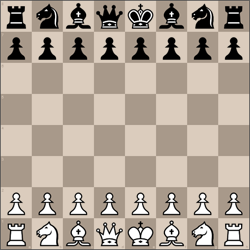 Chess by Herman Steiner 05 Jan 1936, Sun The Los Angeles Times (Los Angeles, California) Newspapers.com
Chess by Herman Steiner 05 Jan 1936, Sun The Los Angeles Times (Los Angeles, California) Newspapers.com
The Los Angeles Times, Chess by Herman Steiner, Sunday, January 05, 1936, Los Angeles, California L. A. Times Problem...
Posted by Bobby Fischer's True History on Wednesday, August 3, 2022
L. A. Times Problem No. 631 By J. Hannelius
White mates in two.
FEN 5n2/n1N1Qp2/2pr1N1K/P1kbRP1P/1p6/1p1P4/1B6/8 w - - 0 1
Solution: 1. Re1 Ne6 2. Nd7#
The Los Angeles Times, Chess by Herman Steiner, Sunday, January 05, 1936, Los Angeles, California L. A. Ties Problem...
Posted by Bobby Fischer's True History on Wednesday, August 3, 2022
L. A. Ties Problem No. 632 By Seppo Salmio
White mates in three.
FEN 8/8/6K1/2PpkP2/3p1p2/3P1P2/8/5NBn w - - 0 1
Solution: 1. Bf2 Nxf2 2. Nh2 Nxd3 3. Ng4#
Max Euwe vs Alexander Alekhine
Alekhine - Euwe World Championship Match (1935), Various Locations NED, rd 26, Dec-03
Dutch Defense: Nimzo-Dutch. Alekhine Variation (A90) 1-0
Alexander Alekhine vs Max Euwe
Alekhine - Euwe World Championship Match (1935), Various Locations NED, rd 27, Dec-06
Vienna Game: Stanley. Alekhine Variation (C27) 1-0
ROUND TWO, WESTERN C SECTION
Alhambra, 4; Highland Park, 4, Hans Grassel, 5; Newcomers, 3, Los Angeles 5; Torrance, 4.
ROUND TWO, EASTERN C SECTION
Exposition, 4½; Ontario, 3½, Oldtimers, 5½; Pasadena Bankers, 2½, Round three: Exposition, 5½; Pasadena, 2½; Ontario, 4½; Pasadena Bankers, 3½.
John A. McCardle, Pasadena CC (white) vs. E. P. Pearson, Exposition Pk. CC (black)
Scotch Game: Scotch Gambit
ANNOTATED BY THE WINNER
(a) If 39. K-N2 N-R5ch; 40. K-N N-B6ch; 41. K-N2 N-R5; drawn.
(b) 41. … R-Q; 42. N-B4 PxP; 43. QxRch QxQ; 44. NxQ PxP; 45. KxP KxN; and White wins.
(c) Mr. Pearson said he would have played 42. … R-N3; but 43. N-B4 PxPdis.ch; 44. NxR PxBdis.ch; 45. KxP Q-B7ch; 46. K-R3 Q-K6ch; 47. K-R4 Q-Q5ch; 48. K-R3 QxR; 49. QxNch KxN; and mate in two, but if 48. … Q-B6ch; 49. K-R4 Q-B7ch; 50. K-N5 Q-N7ch; 51. Q-N4 Q-K4ch; 52. N-Q5 QxR; 53. Q-B4ch (if KxB forced mate in four) but K-Q3; 54. Q-B6ch K-K4; 55. QxN, White wins.
(d) 42. … if R-N3; 43. N-B4 RxB; 44. N-R5 R-N4; 45. R-Q! PxPdis.ch; 46. K-R4 Q-N5; 47. Q-Q6ch K-Q; 48. N-B6ch K-B; 49. NxPch K-Q; 50. Q-B8ch K-B2; 51. NxRch K-N2; 52. N-Q6ch K-N3; 53. Q-Q8ch K-B3; and White forces mate in three.
1934 NORTH AMERICAN MAJOR SECTION A-1
Snowden (white) vs. Stolcenberg (black)
English Opening: Symmetrical Variation
ANNOTATED BY HERMAN STEINER
(a) This variation of the Sicilian Defense was exploded and has not been played in recent tournaments. It usually gives a backwards Queen's Pawn, as shown in the game.
(b) Loss of time. This type of defense requires operation of minor pieces along the base. The Rook move takes a possible square from the Knight.
(c) Well played! The object is P-QN4, utilizing Pawn majority on the Queen's side.
(d) It is obvious that Black's idea of this defense is contrary to the fundamental principles, as he has made four moves with his KN to exchange the White N, which has not lost any moves in development.
(e) See Note (a.) Once can see clearly that Black has no counter chance whatsoever and would have been better off to leave the R at B sq. on his ninth move and play instead of N-K followed B2, P-K3, Q-K2 and R-Q, with the idea of breaking through on Q4.
(f) Too late. White has all his pieces ready to bombard the weak QP.
(g) Another move without point. BxN is no threat because the Black Knight has no good place to retire for future prospects.
(h) A Pawn offer, to gain control of K4 for his N, which White rightly does not accept.
(i) The only move, N-Q4 was a threat which had to be met immediately.
(j) Better drawing chances were offered by playing R-Q6, exchanging Rooks and eventually putting pressure on the QBP.
(k) Not BxP because of R-R. If P-N5, BxPch.
(l) And again not BxP, because of P-N4 followed by R-KR.
(m) Beginning of a fine combination.
(n) Not K-R5 because 53. R-B3 R-N2 or R3; 54. N-B2 followed by K-N2, eventually moving the R, and the mate cannot be stopped.
(o) A very good game played by White, because White performed according to theoretical principles.























